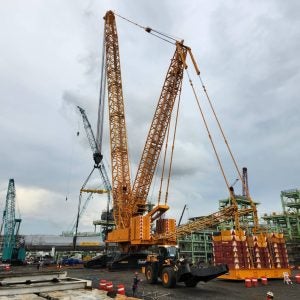The LTM 1300-6.2 is Liebherr’s latest 300 tonne class all terrain crane. The company says that it is the first crane to carry a 90 metre telescopic boom with an axle load of just 12 tonnes. Liebherr says the fast-erecting crane’s high capacity at large hoist heights make it particularly well-suited to erecting tower cranes and antennae, as well as wind turbine maintenance work.
Axle loads
The LTM 1300-6.3 can be driven with different axle loads and gross weights to comply with regulations around the world.
Components, including the telescopic boom and outriggers, have been designed to be installed and removed quickly and easily to help achieve a sub-12 tonne axle load.
Individual telescopic sections can be removed quickly to aid setup for road travel with a gross weight of less than 60 tonnes and axle loads of under ten tonnes.
Liebherr also offers a self-assembly solution enabling the telescopic sections to be removed without the need for an auxiliary crane. This is also compatible with other models such as the LTM 1650-8.1 and the LTM 1450-8.1.
Eight-section boom
The crane’s 90-metre boom length is achieved via an eight-section telescopic boom – one section more than similar cranes in this class, said Liebherr. To ensure that the boom plus all outriggers and the hook block can be driven on public roads with an axle load of 12 tonnes Liebherr has optimised the steel construction of the crane to be as lightweight as possible.
Lattice jibs
Lattice jibs available include: an 11.5 to 20 metre double folding jib; two seven metre lattice sections to extend the telescopic boom; a 39 metre fixed jib; and a 43 metre hydraulically adjustable fixed jib. This enables the crane to reach hoist heights of up to 120 metres. Certain lattice sections are also compatible with other models in the Liebherr’s portfolio.
Wind speed load chart options
The LTM 1300-6.3 has different load charts available for various wind speeds designed to provide enhanced safety and longer operating times in windy conditions. According to Liebherr, load charts for cranes are generally only valid for gust wind speeds of up to 9 m/s. To ensure that work can continue safely in even higher wind speeds, the company has calculated the load charts for additional maximum wind speeds and programmed them into the crane’s control system. For the LTM 1300-6.3, for example, it is 11.2 m/s, or even 13.4 m/s when using lattice equipment.
In pure telescope mode, the tables allow for a speed of 15.6 m/s. If the wind speed measured on the crane’s boom during a job exceeds the set chart wind speed, the crane operator has the option to switch to a load chart with a higher maximum wind speed, possibly the job to be continued.
The crane also comes with Liebherr’s ECOmode, ECOdrive, VarioBase Plus, VarioBallast, and Auto-Ballast technology. ECOmode is designed to help reduce fuel consumption and noise emissions. The pump drive is automatically disconnected when the engine is idling and then reconnected by the controller when required. ECOmode ties-in with Liebherr’s single-engine strategy. The weight reduction created by removing the superstructure engine was used to deliver the longer boom and more ballast with an axle load of 12 tonnes, said Liebherr.
ECOdrive is designed to save fuel and reduce noise. An eight-cylinder Liebherr diesel engine in the undercarriage provides 455 kW / 619 bhp and 3,068 Nm of torque. The power is transferred to the crane axles by a 12-speed ZF TraXon torque gearbox. A torque converter aids manoeuvring.
VarioBase Plus means the crane’s rear supports have a double-stage design with a support width of 9.4 metres – two metres wider than the front supports. This increases the capacity over the rear supports, said Liebherr. The single-stage front outriggers also have a lower weight, it adds.
The VarioBallast means the LTM 1300-6.3 can be operated with two different ballast radii: 4.94 m or 5.94 m. The ballast radius is designed to be reduced quickly and easily by one metre using standard mechanically adjusted ballasting cylinders. This is one of the main benefits of the new 300-tonne model when used in constricted conditions, said Liebherr. The large ballast radius achieves maximum capacity. With VarioBallast the crane can be operated with eight tonnes less ballast compared to the LTM 1300-6.2 without any significant reduction of its lifting capacity, reducing both transport logistics and CO2 emissions.
Ballast
Auto-Ballast enables the ballast to be secured to the turntable at the touch of a button. It is designed to take the strain off the crane operator and enhance safety, particularly for routine procedures.
The maximum ballast on the LTM 1300-6.3 is 88 tonnes. The ten-tonne suspended ballast blocks on the right and left are compatible with the LTM 1230-5.1 and LTM 1250-5.1 crane models.
Individual ballast slabs have been modified in terms of their weight and dimensions to make them economical for transport and fast and easy to set up on site. All the ballast can be placed on the crane with just five hoists, said Liebherr. The basic ballast of 42 tonnes has a width of just three metres to fit within the overall width of the vehicle. This, Liebherr said, makes it significantly easier to move the fully set-up crane on constricted sites.
An optional central lubrication system for the king pin bearings on the chassis is a new feature. It is designed to deliver grease to 24 lube points automatically. Six LED rear lights to illuminate the working area are also available.
The LTM 1300-6.3 succeeds the LTM 1300-6.2 which, with its 78-metre telescopic boom, remains still available.






